How to Draw a Eye Crying Easy
Learning how to draw tears is an interesting exercise, for one, it is a powerful image and can be used in various artworks. Secondly, learning how to draw tears teaches you how to draw water and eyes, which are contextualized in a single image. As we learn how to draw tears, we will see that the process is quite simple and easy. Learning how to draw realistic tears is a very useful skill to have as it can be utilized in all sorts of genres of art. Drawing tears can be a profound image used on its own or it can be a great addition to character drawing in the genre of horror, fantasy, and all sorts of interesting ideas. A teardrop drawing will also refine your understanding of creating a water feature as well as the shape and form of the eye, which will contextualize the tear.
Table of Contents
- 1 An Easy Guide to Drawing Tears
- 1.1 Necessary Materials
- 1.2 Preparation
- 2 Step-by-Step Instructions on How to Draw Tears
- 2.1 Step 1: Sketching the Eye
- 2.2 Step 2: Sketching the Tears in the Eye
- 2.3 Step 3: Shading With Pen
- 3 Tips to Remember
- 4 Frequently Asked Questions
- 4.1 How Do You Draw a Tear Shape?
- 4.2 How Do You Shade in a Teardrop?
An Easy Guide to Drawing Tears
As we learn how to draw a tear, we will see that we will also need to know how to contextualize the teardrop drawing with an eye. The process of drawing tears is not necessarily difficult, it just needs to be broken up into digestible steps. In this tutorial on how to draw realistic tears, we will look at how to draw a teardrop with an eye, broken up into a few simple steps. As we go through this tutorial, we will see how we develop a simple teardrop drawing into a realistic teardrop drawing.
Drawing tears will also teach us how to construct seemingly complicated images using a simple set of tricks, where we start with simple shapes, refine them, and then add detailing to the drawing for a more realistic image.
Necessary Materials
In this tears drawing, we will be working with pencil and pen to create a realistic teardrop drawing. Learning how to draw a teardrop using a ballpoint pen will help us to give finer lines to our teardrop drawing, giving it a sharper and more realistic quality.
We will want to make sure that we have an HB and 2B pencils for the earlier stages of the tutorial.
This is because we will work out the basic shapes and forms before moving on to the pen drawing stage. We will want to make sure we have an eraser and sharpener for our pencils for the earlier drawing process. Lastly, we will want to have some decent paper for this tutorial.
- HB pencil
- 2B pencil
- Ballpoint pen
- Eraser
- Sharpener
- Good paper (200 g/m – 250 g/m recommended)
Preparation
Once we have all our materials for this teardrop drawing, we can begin to prepare ourselves for the drawing process. Any drawing process requires a good table and a space with minimum distractions. However, playing some music during this tutorial is a great way to enjoy the process in a relaxing and fun way. We want to make sure that we have all our materials ready on a table set out before us.
We will not be using a reference image in this tutorial; however, you can find any image on the internet of an eye to help you form the eye for the teardrop drawing process. Let us see what we should expect from this tutorial on how to draw tears.
Step-by-Step Instructions on How to Draw Tears
Learning how to draw tears seems complicated, however, the process is quite simple. In this tutorial, we will learn how to draw realistic tears by starting with a simple eye drawing. We will first work out the generic shape of the eye, which we will then refine by adding details and shading with our pencils.
From there, we will add the tear to the pencil drawing, where we incorporate the watery eye and teardrop into the drawing. From there we can refine the tear and eye with some pencil shading. Lastly, we will add penwork and pen shading to further enhance the contrast and the sharpness in the teardrop drawing.
Now that we are aware of what this tutorial will entail, let us go through the process of creating a realistic teardrop drawing.
Step 1: Sketching the Eye
As we begin our tears drawing, we want to start by creating a simple sketch with our HB pencil. We want to lightly draw the basic eye shape, to which we will add detailing as we go through the tutorial.
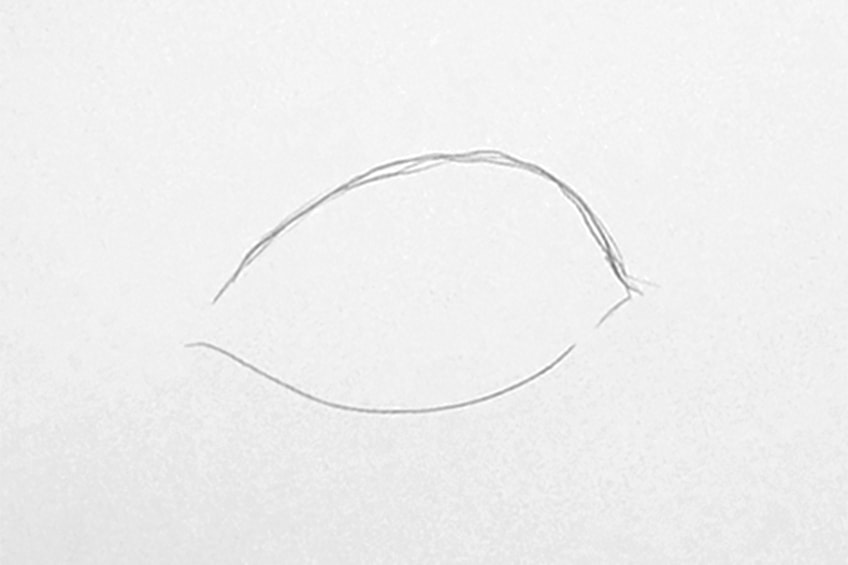 For us to contextualize the tears, we will need to capture the eye as best we can. During this early stage of sketching, perhaps use an image from the internet to guide you in forming the basic shape of the eye as well as the details around the eyes.
For us to contextualize the tears, we will need to capture the eye as best we can. During this early stage of sketching, perhaps use an image from the internet to guide you in forming the basic shape of the eye as well as the details around the eyes.
Feel free to use any image of tears for this, as we do not have a specific source image for this tutorial.
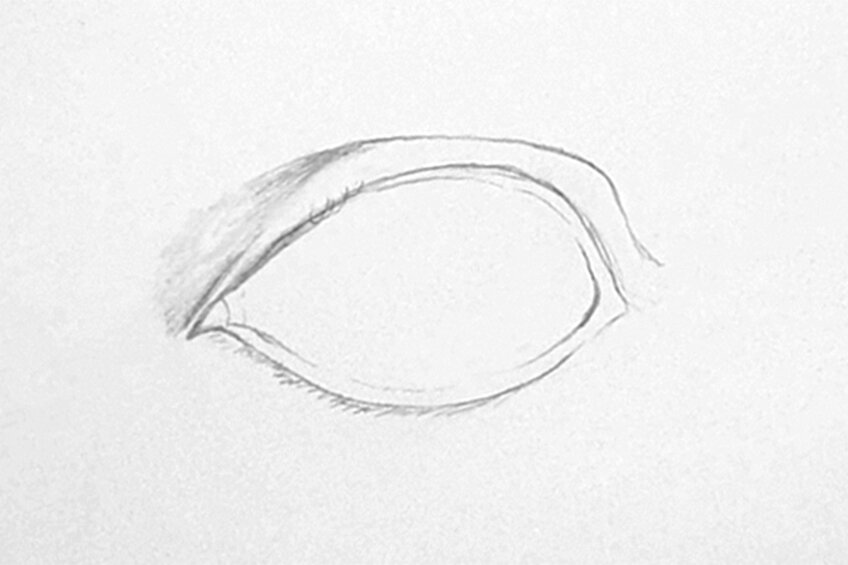 As we sketch the eye, we want to make sure we capture all the essential details, such as the fold of the eyelids around the eye, and all the details in the eye. We want to make a simple light sketch of the eye with all the defining features.
As we sketch the eye, we want to make sure we capture all the essential details, such as the fold of the eyelids around the eye, and all the details in the eye. We want to make a simple light sketch of the eye with all the defining features.
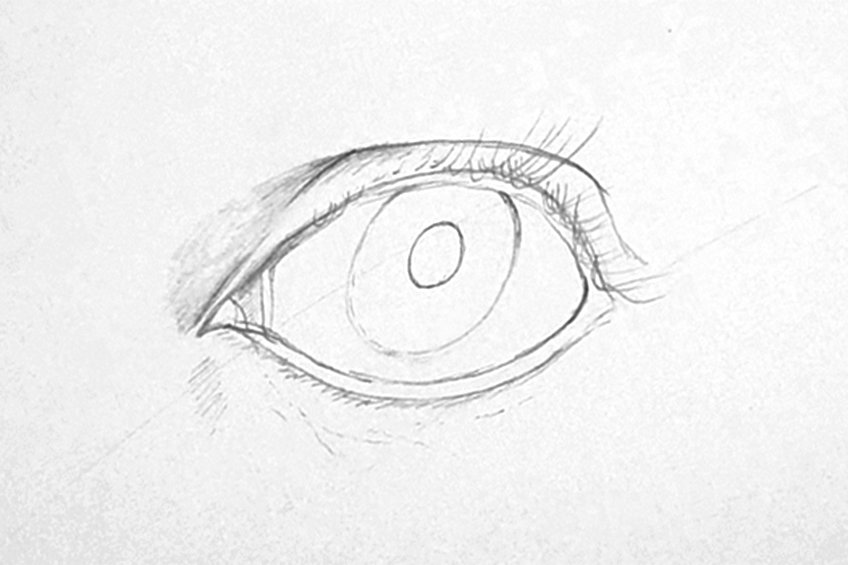 Again, you can use any eye as a reference from the internet, as long as you just create a light sketch of the eye at this point. That being said, we will want to incorporate reflections in the eye, regardless of which eye we draw.
Again, you can use any eye as a reference from the internet, as long as you just create a light sketch of the eye at this point. That being said, we will want to incorporate reflections in the eye, regardless of which eye we draw.
By doing this, we will create a teary quality in the eye.
 We can do this by carrying on with the drawing process, where we add all the details to the eye with our pencils. However, we now want to draw little shapes in the eye, specifically around the iris and pupil.
We can do this by carrying on with the drawing process, where we add all the details to the eye with our pencils. However, we now want to draw little shapes in the eye, specifically around the iris and pupil.
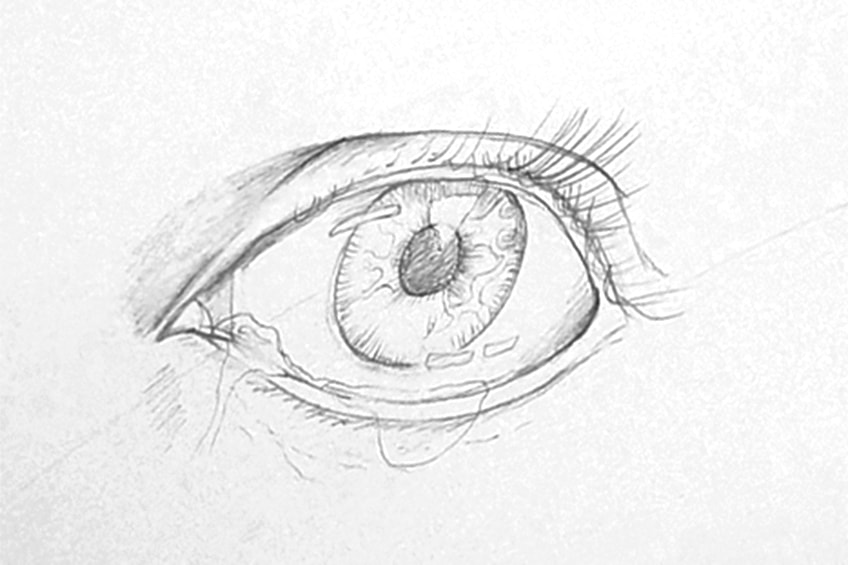
Step 2: Sketching the Tears in the Eye
As we draw little shapes into the eye, specifically around the iris and pupil we will eventually shade around those shapes to make them a highlight in the eye. We can also proceed to add in a tear near the bottom of the eye.
Tears can be all sorts of shapes, however, let's keep it simple for now.
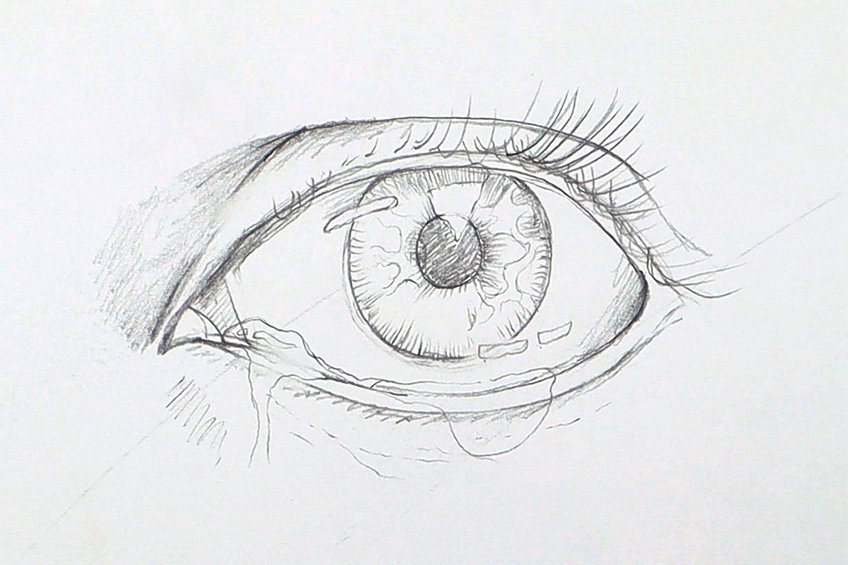 Let's proceed to draw a smaller elongated teardrop as if it is falling onto the face. We can do this by drawing an upside-down balloon shape, which we can connect to a larger shape in the eye with a thin strand between them. We can also create a larger drooping teary shape, which can sit on the other side of the eye.
Let's proceed to draw a smaller elongated teardrop as if it is falling onto the face. We can do this by drawing an upside-down balloon shape, which we can connect to a larger shape in the eye with a thin strand between them. We can also create a larger drooping teary shape, which can sit on the other side of the eye.
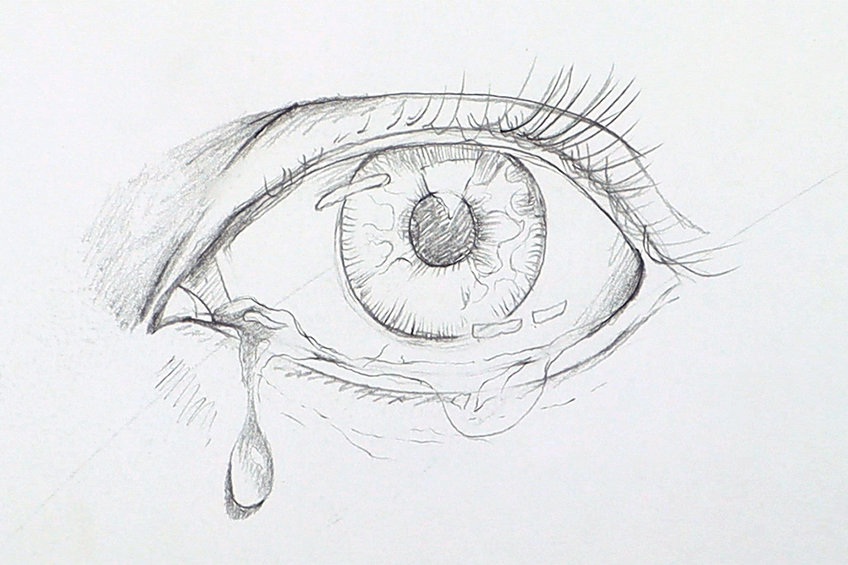 You can play around with how you shape the tear in the eye, as long as the shading aspect is correct. We shade in the tears by creating a light layer of gray shading over the whole eye, leaving out the little shapes that we drew into the eye.
You can play around with how you shape the tear in the eye, as long as the shading aspect is correct. We shade in the tears by creating a light layer of gray shading over the whole eye, leaving out the little shapes that we drew into the eye.
With the teardrops themselves, we want to shade one side in the teardrop and add shadows on the outside of the teardrop opposite to the side we shading in.
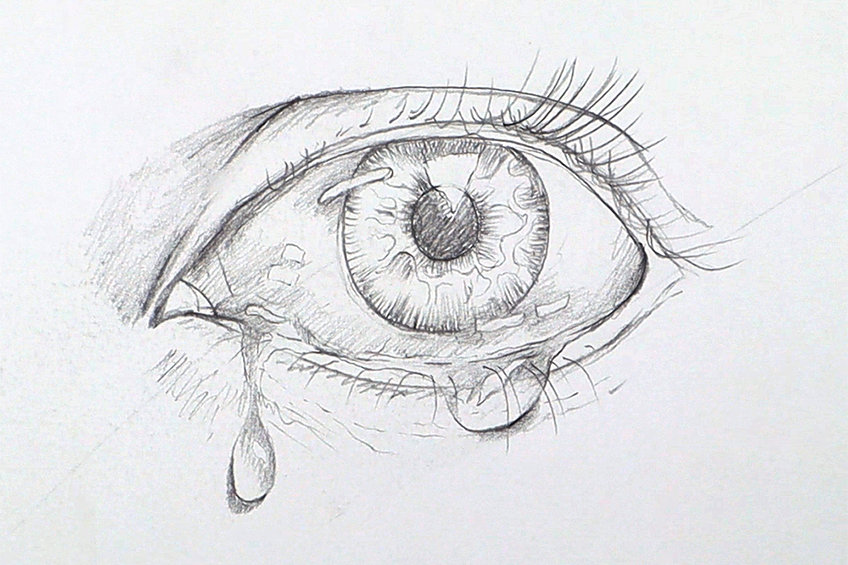 With teardrops, you simply can add in any shape, as long as it is rounded at the bottom to suggest that it is falling downward. The way you shade in these shapes is to add shading inside the teardrop on one side, as well as adding a little shadow outside of the teardrop to suggest that it is casting a little shadow.
With teardrops, you simply can add in any shape, as long as it is rounded at the bottom to suggest that it is falling downward. The way you shade in these shapes is to add shading inside the teardrop on one side, as well as adding a little shadow outside of the teardrop to suggest that it is casting a little shadow.

Step 3: Shading With Pen
We now will bring these features to life by giving them finer and more contrasted marks. With your ballpoint pen, you want to lightly shade over the white areas of the eye as lightly as possible. As you do this, you want to shade around the little shapes that you have drawn in the eye, leaving them blank.
 As you lightly shade the eye with a light layer of gray with your ballpoint pen, you can proceed to go over the details of the eye that you have drawn with a pencil. This means that we can draw the details of the eye as normal, but as we do so we simultaneously want to lightly shade around all the little shapes that we have drawn in the eye.
As you lightly shade the eye with a light layer of gray with your ballpoint pen, you can proceed to go over the details of the eye that you have drawn with a pencil. This means that we can draw the details of the eye as normal, but as we do so we simultaneously want to lightly shade around all the little shapes that we have drawn in the eye.
As we leave out the little shapes in the eye, they will start to look like reflections in a teary eye.
 This is where you want to spend time slowly working through your drawing. Especially around the iris and pupil, you can add in the fine drawing details with your pen, as long as you leave an empty white shape somewhere in the middle of the eye. By doing this you will create maximum contrast between the details of the eye and the highlights or reflections.
This is where you want to spend time slowly working through your drawing. Especially around the iris and pupil, you can add in the fine drawing details with your pen, as long as you leave an empty white shape somewhere in the middle of the eye. By doing this you will create maximum contrast between the details of the eye and the highlights or reflections.
 As we shade lightly with our ballpoint pens, we want to make sure that we shade into the teardrop shapes at the bottom of the eye. As we get to the teardrop shapes, we want to make sure we don't shade them in completely. We want to leave white space on one side of the teardrop shape.
As we shade lightly with our ballpoint pens, we want to make sure that we shade into the teardrop shapes at the bottom of the eye. As we get to the teardrop shapes, we want to make sure we don't shade them in completely. We want to leave white space on one side of the teardrop shape.
Doing this will give the teardrops a transparent quality.
 Again, we will fill in all the details of the eye, going over the pencil marks with our pens. However, wherever the eye would be white around the iris, we will add a light layer of gray. That being said, we want to make sure we leave little shapes in the eye, untouched and not shaded in. As we do this, we give a glossy effect over the entire eye, and the shapes become reflections.
Again, we will fill in all the details of the eye, going over the pencil marks with our pens. However, wherever the eye would be white around the iris, we will add a light layer of gray. That being said, we want to make sure we leave little shapes in the eye, untouched and not shaded in. As we do this, we give a glossy effect over the entire eye, and the shapes become reflections.
 As the teardrops are seemingly falling over the bottom eyelids, we can add linework going through the teardrops, suggesting that we can see the eyelid through the teardrops. By doing this, we suggest the transparent quality of the teardrop a little more.
As the teardrops are seemingly falling over the bottom eyelids, we can add linework going through the teardrops, suggesting that we can see the eyelid through the teardrops. By doing this, we suggest the transparent quality of the teardrop a little more.
As we proceed, we can also begin to add in the other details of the eye, including the eyelashes and shading around the eye.
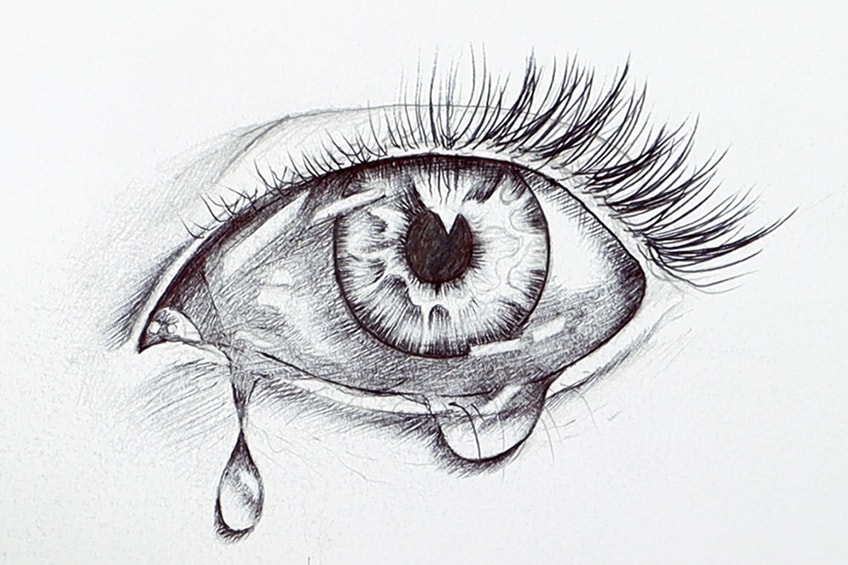 The aim should be to draw all the details as you normally would, but this time, you will add light shading over the white areas of the eye with little negative shapes in the eye. This shading will extend into the teardrops, where details can be drawn through slightly to suggest transparency. From here, we can simply add the rest of the details to and around the eye.
The aim should be to draw all the details as you normally would, but this time, you will add light shading over the white areas of the eye with little negative shapes in the eye. This shading will extend into the teardrops, where details can be drawn through slightly to suggest transparency. From here, we can simply add the rest of the details to and around the eye.
 As we shade the eye with our ballpoint pens, we want to make sure that there is a shadow under the upper eyelid. This means we can slightly darken the upper area in the eye, to suggest shadow casting from the upper eyelid.
As we shade the eye with our ballpoint pens, we want to make sure that there is a shadow under the upper eyelid. This means we can slightly darken the upper area in the eye, to suggest shadow casting from the upper eyelid.
Again, proceed to shade as normal, except for leaving out the little shapes that have been drawn into the eye.
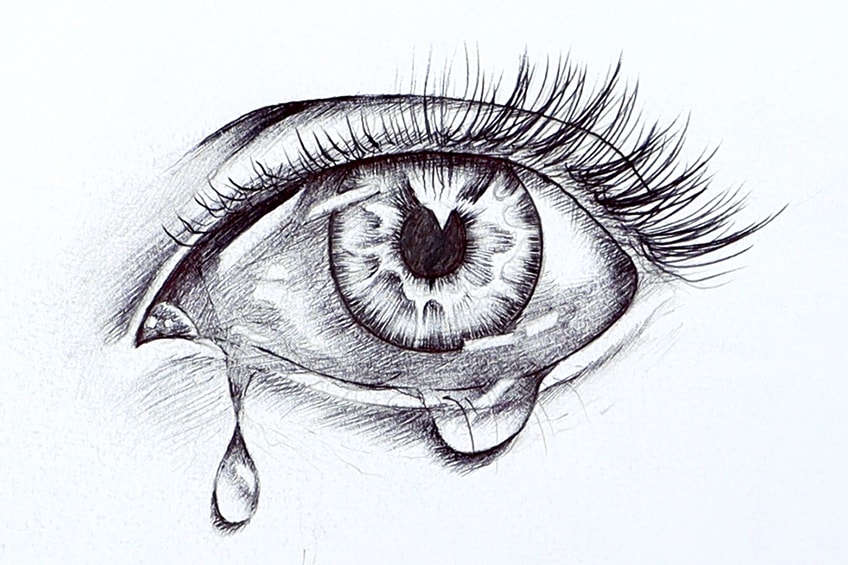 We should be left with a relatively realistic teary eye at this point. Again, all eyes are different but you only need to remember two key rules. Draw little geometric shapes in the eye that you leave untouched to suggest reflection. The other is to capture teardrop shapes that form near the bottom of the eye. With a teardrop drawing, you want to create a teardrop and teary eye as well.
We should be left with a relatively realistic teary eye at this point. Again, all eyes are different but you only need to remember two key rules. Draw little geometric shapes in the eye that you leave untouched to suggest reflection. The other is to capture teardrop shapes that form near the bottom of the eye. With a teardrop drawing, you want to create a teardrop and teary eye as well.
 Lastly, we can proceed to draw in the eyebrow. By doing this, we further contextualize the teary eye, giving it a more realistic quality of sadness or whichever expression you aim to convey. The eyebrow can be a great emotional suggestion in a teardrop drawing.
Lastly, we can proceed to draw in the eyebrow. By doing this, we further contextualize the teary eye, giving it a more realistic quality of sadness or whichever expression you aim to convey. The eyebrow can be a great emotional suggestion in a teardrop drawing.
This is because the shape of the brow can define the emotion of the crying eye.
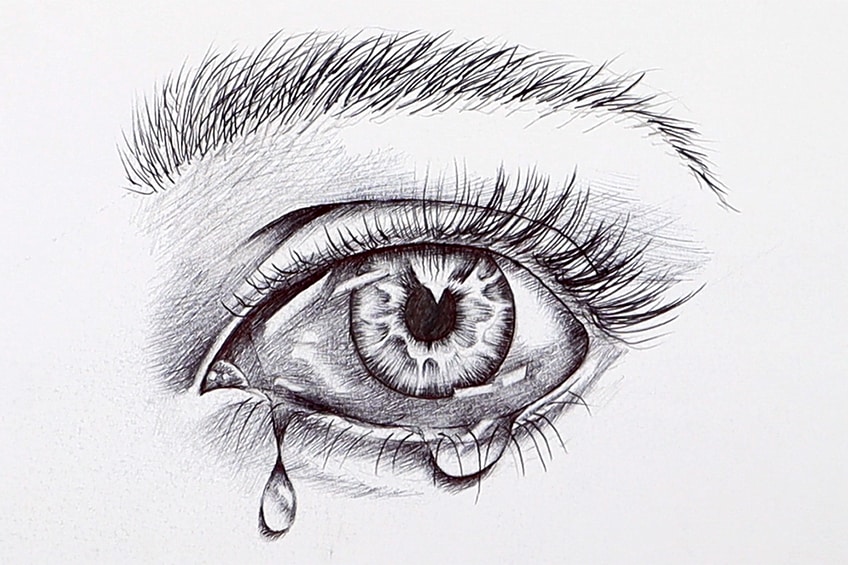 The bottom eyelashes can be drawn normally, even going through the teardrops. This just helps to suggest that the teardrop is like a permeable structure where the lash can go through it. We also want to add light shading around the brow and above the eye, just to add dimension to the eye.
The bottom eyelashes can be drawn normally, even going through the teardrops. This just helps to suggest that the teardrop is like a permeable structure where the lash can go through it. We also want to add light shading around the brow and above the eye, just to add dimension to the eye.
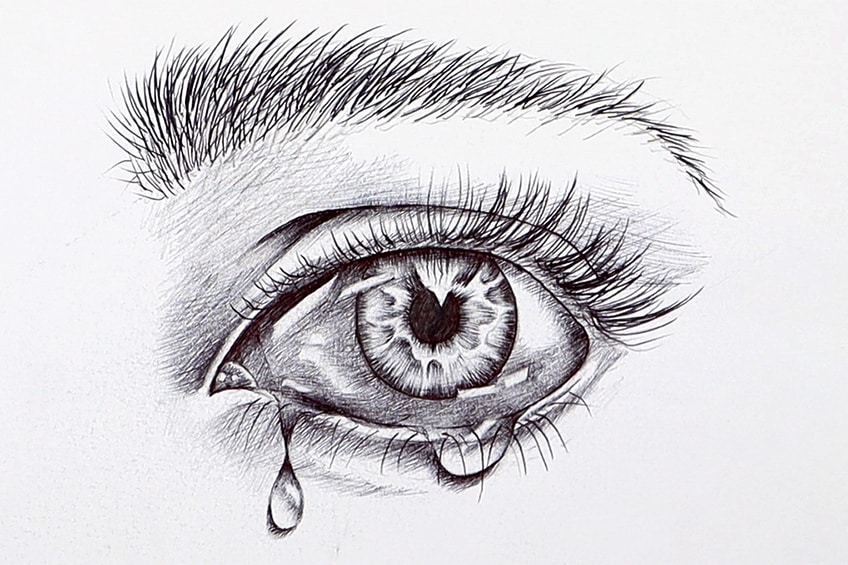 As you shade in the eye a little more, remember to take a break. Coming back to your work feeling fresh can often be the best way to capture the details a little more effectively. This is also helpful with the shading process as you continue to add shading into the drawing. We want to make sure we contextualize the teardrop drawing by giving the eye dimension and realism. This can be done by shading around the eye as well. We want to make sure that we shade in the floods around the eye.
As you shade in the eye a little more, remember to take a break. Coming back to your work feeling fresh can often be the best way to capture the details a little more effectively. This is also helpful with the shading process as you continue to add shading into the drawing. We want to make sure we contextualize the teardrop drawing by giving the eye dimension and realism. This can be done by shading around the eye as well. We want to make sure that we shade in the floods around the eye.
Additionally, we want to shade under the eye as well.
 You can continue this process until you are satisfied with the result of your drawing. Drawing a teardrop is not difficult and can be added to any eye drawing. As long as you capture the shape of teardrops at the bottom of the eye and add in reflections, the eye will most likely result in a teary eye teardrop drawing.
You can continue this process until you are satisfied with the result of your drawing. Drawing a teardrop is not difficult and can be added to any eye drawing. As long as you capture the shape of teardrops at the bottom of the eye and add in reflections, the eye will most likely result in a teary eye teardrop drawing.
Tips to Remember
- Take your time. Work out the pencil sketch of the eye and tear, capturing their form and shape before moving on to drawing in a pen.
- Use an image of an eye for reference. This can be found through various resources on the internet.
- Be cautious when drawing with a pen. A good suggestion is to use some scrap paper to scribble on now and then to remove any excess ink from the tip of the pen.
- Take a break. Drawing is strenuous, and taking a break can be a great way to come back to the drawing with fresh eyes.
- Making the eye darker will give the eye more shine. Try to keep the eye in a gray tone, as this way, the highlights in the watery eye shine more distinctly.
- Enjoy the process. Don't worry about the drawing being perfect the first time, use this tutorial as a resource to guide you in your drawing practice.
Learning how to draw tears is a fun task because all eyes are different and all tears fall differently. Playing around with the water shine in the eyes can be done in all sorts of ways. However, to depict the redness of an eye with pen and graphite pencil, you want to shade the eye slightly darker than usual. By doing this, we can allow for the highlights in the teardrops to stand out more. From here, it's simply a matter of drawing the details of the eye as best as possible. As long as you remember that you want to make the eye teary by creating reflections using shapes, paired with actual teardrops at the bottom of the eye, the drawing will result in a more realistic image.
Frequently Asked Questions
How Do You Draw a Tear Shape?
The teardrop is like a balloon shape turned upside down. However, water can take all forms and the teardrop shape can be played around with. The most important aspect of capturing a tear shape is working with rounded and circular shapes. This means we can elongate the tear to fall down the face or shorten the length of the teardrop, but we want to maintain the rounded bottom of the water drop. The rounded bottom or head of the teardrop also implies that gravity is pulling the water drop downward, where the bottom of the tear is larger than the upper section of the tear. This gives the tear a unique falling quality, with a pointed or narrow upper section and a ball-like or rounded bottom section. As you create the teardrop drawing, you can give the tear an elongated quality as long as you maintain the rounded bottom section, thus creating a realistic teardrop effect.
How Do You Shade in a Teardrop?
Learning how to draw the teardrop or a water drop in an effective way requires you to understand that the tear is a transparent organic structure. This means that light moves through the structure and refracts light backward. This means that the teardrop works in a similar capacity and allows the light and shadow to move around the tear and be present on both sides of the tear. This means that there is going to be a shadow on both sides of the tear regardless of which direction the light source comes from. The same applies to the light reflections in the tear, which means there will be a light reflection on both sides of the tear. Because the structure of a teardrop is quite abstract, we can also play around with distorting details within the tear. This is a realistic representation of what a tear or transparent water drop will do, which makes it an easy structure to draw.
Source: https://artincontext.org/how-to-draw-tears/
Belum ada Komentar untuk "How to Draw a Eye Crying Easy"
Posting Komentar